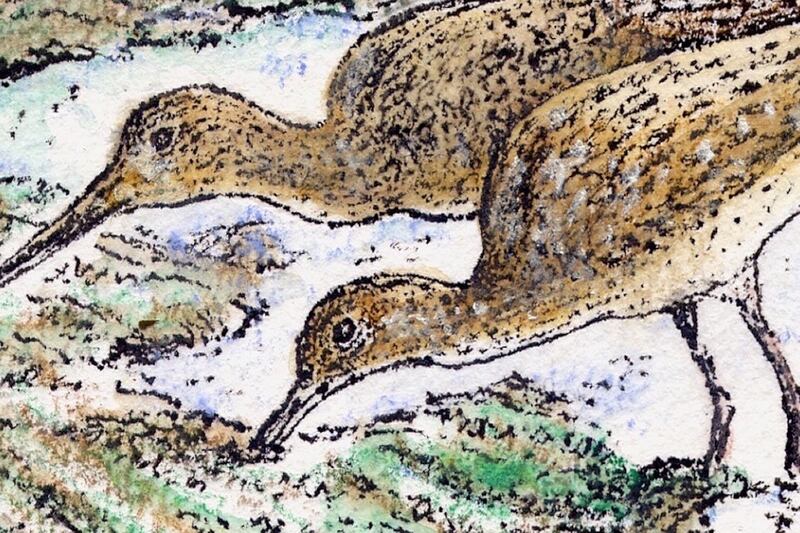A broad wedge of tall and tight-packed reeds divides the last raggedy fields at the edge of the strand. To me it’s a marsh; a few hectares of land lost in a tawny fog, at the foot of a low cliff, the mountain river running nearby.
Sometimes in winter enough water floods in to set up glittering spaces for whooper swans to settle on. Once, a dozen of them flew up suddenly to amaze me - “a sharing of space,” I rhapsodized, “a determination of arc, an excited, confirmatory chorus”. Goodness.
That, it seems, is as much as I know of the wildlife of the marsh; a lost piece of landscape I have passed countless times along the boreen to the shore. Even Sunday shooters who sometimes prowl around its edge have never – in my hearing, that is – actually shot a duck, though marshes and mallard should go together.
I have guessed that certain of the splay-footed Rallidae – the family of moorhen and coot – must be in there somewhere, too, if only I’d watch for long enough and if the mink hasn’t killed them all by now.
A recent image of a corpse sent to “Eye on Nature” has, however, introduced a further reed-land bird, its observation needing patience not given to many men and exercised most productively in winter, when water rails most often venture forth.
As one of them, the Belfast ornithologist Anthony McGeehan, has written: “If you can live with just hearing this species, rather than seeing it, you will avoid much frustration.”
Our ornithological friend and neighbour, David Cabot, has heard the birds 'squealing like pigs' in marshy areas of a lake on the headland
And even our ornithological friend and neighbour, David Cabot, who knows every feather of these wetlands, confesses only to auditory encounter.
He has heard the birds “squealing like pigs” in marshy areas of a lake on the headland, too small and lost to have a name. The simile is standard for vocalisations of the water rail, Rallus aquaticus, even among birders (sometimes piglets are preferred).
The rail that turned up dead on a suburban footpath in south Dublin last month was a match for a similar rare fatality in Bray, Co Wicklow, in March, puzzling some inquisitive and bird-wise children on their way home from school. Both finds matched seasonal peaks in winter migration of European water rails to and from Ireland. They fly at night, so east coast suburbs strung with wires may enter the story.
The generally weak flight of the Rallidae family, on short, rounded wings, make any long migration seem improbable. Yet the corncrake – otherwise the land rail – does it too, with even further to fly.
A water rail deserves to show itself more often. Along with boldly-streaked back and bright red dagger of a bill, comes McGeehan’s observation of “velveteeen, slate-grey underparts [that] glow with a bluish light”.
My illustration borrows from his photograph in the excellent Birds Through Irish Eyes (2012).
His book told me something else I didn’t know, that the bird can, on occasion, be murderous. Smaller and slimmer than the moorhen, and pushing through narrower gaps between the reeds, it has been known to kill wren, sparrow and blue tit for food, drowning them beneath its capacious claws. One has to wonder what these were doing in such watery shadows in the first place.
Ireland’s water rails are resident and abundant and were once an occasional offering in winter on food market stalls of Dublin. Today they are an ecological “umbrella species” for monitoring the general quality of reed-bed habitats – monitoring, that is, acoustically, through taping their responses to the broadcast of rail mating calls.
Our feral American mink now top the list of water-bird predators, topped up by wrong-headed 'liberation' raids by animal activists on fur farms
BirdWatch Ireland seems to have monitored enough wetlands to rate the rails as “amber-listed”, citing a decline in their breeding populations. In Europe, for once, the species is reckoned as “secure”.
Our feral American mink now top the list of water-bird predators, topped up from time to time by wrong-headed “liberation” raids by animal activists on the remaining handful of fur farms.
The toll on Ireland’s ground-nesting and marsh-nesting birds has been incalculable. Any consistent mink control is limited to protecting game birds and inescapably important conservation areas. Mink, meanwhile, have swum even to islands off the west.
Gun clubs have helped to curb the predatory impact of mink freed or released from farms and a once-off mink bounty of €3 per furry mink tail was offered in 2012.
There have been calls for further bounty schemes. But most wildlife biologists see them as temporary and local expedients and a waste of money. Mink are now a naturalised Irish species and their balance will be found in this island’s particular, wetland-rich ecosystem, with its own competitions for territory and prey.
We have to trust there will eventually be room for a modest abundance of Mustela vison, the once-American mink, and enough remaining, if mostly invisible, Rallus aquaticus to greet the day with piglety squeals.





